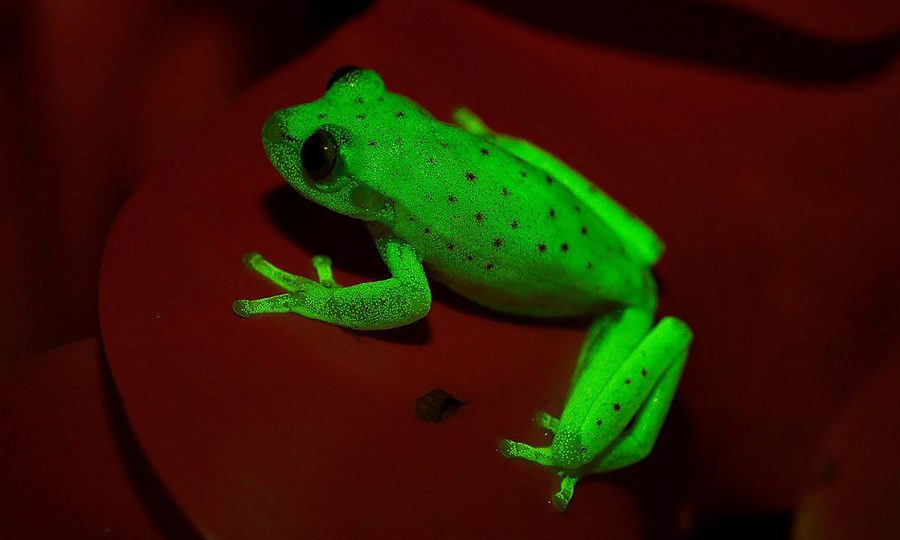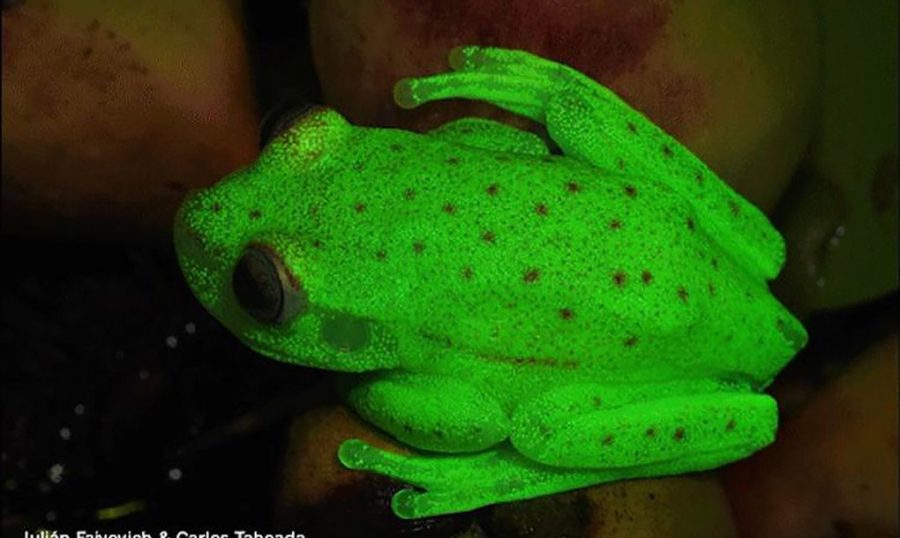Scientists have found a new species of fluorescent frog in Argentina., and it is fluorescent. The South American polka dot tree frog appeared as a common-looking frog to the researchers, but when they analyzed the amphibian closely, they discovered that when placed under an ultraviolet light it glows in a bright blue-green light.
The discovery marks the first time that an amphibian has proven to be fluorescent, although this unusual trait is not unheard of in the animal world. In previous research, scientists have found that some types of fish and turtles can produce a fluorescent light, as well as parrots and scorpions.

The polka dot tree frog is unique among fluorescent animals
A study regarding the new species was published Monday in Proceedings of the National Academy of Sciences. Co-author Norberto Peporine Lopes of the University of Sao Paulo explained that once they started studying the frog, they were surprised yet again analyzing the interactions between the chemical agents that cause the frog to fluoresce, as reported by The Inquisitr.

“Three molecules -hyloin-L1, hyloin-L2, and hyloin-G1- in the animals’ lymph tissue, skin and glandular secretions were responsible for the green fluorescence. The molecules contain a ring structure and a chain of hydrocarbons, and are unique among known fluorescent molecules in animals,” said Lopes, according to The Inquisitr.
Fluorescent creatures absorb light from their surroundings in short wavelengths and re-cast that light in longer wavelengths. The newly found fluorescent frog is one of a kind —in the fluorescent animal— and researchers were not quite sure why, although they did explain some possible theories on their research.
Mating mechanism
The South American polka dot tree frog (Hypsiboas punctatus) can emit about 18 percent of a full moon’s capability to cast light, and according to Nature, that is the right amount of light that would allow fellow frog species to see their surroundings.
“We show that fluorescence contributes 18-29% of the total emerging light under twilight and nocturnal scenarios, largely enhancing brightness of the individuals and matching the sensitivity of night vision in amphibians. These results introduce an unprecedented source of pigmentation in amphibians and highlight the potential relevance of fluorescence in visual perception in terrestrial environments,” the study reads.
Researchers believe fluorescence can also be used by the polka dot tree frog as a way for males to attract females. The fluorescence could help females locate males.
Glowing animals are not so new
In 2011, a researcher named Eric Poeschla, of the Mayo Clinic in Rochester, Minnesota, produced three glowing GM (genetically modified) cats by using a virus able to carry a gene dubbed green fluorescent protein.
Poeschla developed the GM cats to study HIV/Aids to possibly understand the feline and human virus thoroughly. The method was not unheard of. In 2008, researchers at the Yerkes National Primate Research Center in Atlanta, developed a glowing rhesus macaque monkey to study Huntington’s disease, and earlier in 2006 researchers at the National Taiwan University implanted green fluorescent protein into pigs.

Scientists have expressed their excitement over the recent findings. Marine biologist David Gruber believes that the new study could spur new research projects to determine the purpose of fluorescence in animals.
Gruber has experience in the study of bioluminescent and fluorescent animals, and back in 2015, he traveled to the Solomon Islands to film biofluorescence in small sharks and reefs, when out of nowhere a fluorescent sea turtle swam towards him. The hawksbill sea turtle, an endangered species, was the first reptile scientists found to be biofluorescent, and Gruber’s team was able to record it.
The researcher is also responsible for filming the first fluorescent fish on the wild. In 2011, he was on Little Cayman Island in the Caribbean filming biofluorescent corals, and as he was doing so, a small glowing eel swam near him. That species of eel has not been caught on tape since.
So far, Gruber’s work has helped to identify over 180 species of biofluorescent fish, and he describes the ocean as a large blue filter that blocks other colors of the light spectrum, leaving fish with fluorescence to create other colors in their world.
Another scientist, herpetologist Julian Faivovich of the University of Buenos Aires, told Nature that he intends to study the remaining 250 species of tree frogs in South America, and he expects that his colleagues would be interested in the phenomenon and start carrying UV lights to the field.
Source: Nature
